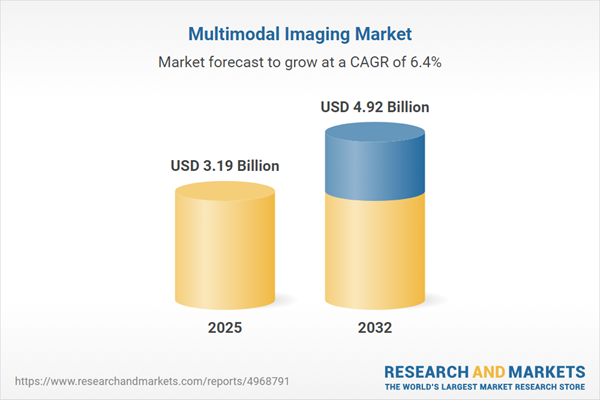Speak directly to the analyst to clarify any post sales queries you may have.
As integrated care shapes the next era of healthcare, the multimodal imaging market plays a pivotal role in advancing digital transformation for senior executives focused on quality outcomes, operational resilience, and strategic growth.
Market Snapshot: Multimodal Imaging Market Size, Growth, and Outlook
The global multimodal imaging market is valued at USD 3 billion and is projected to reach USD 3.19 billion by 2025, achieving a compound annual growth rate of 6.37%. Market expansion is driven by technological evolution in hybrid imaging systems, ongoing healthcare infrastructure upgrades, and increased adoption across multiple clinical fields. Strategic investments in digital capabilities and interoperability are extending access to innovative diagnostic technology. As new care models reshape the industry, sector partnerships and a focus on technology integration are proving central for competitive advantage. Market leaders are aligning operational strategies to foster sustainable growth and maintain high standards of care delivery.
Scope & Segmentation of the Multimodal Imaging Market
- Component: Includes secure hardware foundations, adaptable software solutions, and scalable services for reliable data management, platform stability, and enhanced teamwork across clinical and research teams.
- Imaging Modality: Covers PET CT, PET MR, and SPECT CT systems that integrate anatomical with functional imaging, facilitating accurate diagnoses and supporting multidisciplinary treatment pathways.
- Application: Integrates use in cardiology, neurology, and oncology, empowering departments to perform comprehensive patient stratification, monitor therapies, and enable evidence-based decisions for resource optimization.
- End User: Ranges from hospitals and clinical centers to research institutes and academic entities that utilize advanced imaging to drive research, uphold care standards, and foster knowledge exchange throughout the sector.
- Regions: Spans the Americas, Europe, Asia-Pacific, Middle East, and Africa, with adoption trends influenced by local regulations and the maturity of digital health infrastructures. These distinctions necessitate tailored strategies for market entry and sustained operations.
- Companies Analyzed: Includes General Electric Company, Siemens Healthineers AG, Koninklijke Philips N.V., Canon Medical Systems Corporation, and Fujifilm Holdings Corporation, along with innovators such as PerkinElmer, Bruker Corporation, United Imaging Healthcare, Mediso Medical Imaging Systems, and MR Solutions.
Key Takeaways: Strategic Insights for Senior Decision-Makers
- Unified imaging workflows are breaking down data silos, streamlining collaboration, and preparing organizations for value-based care transitions and multi-specialty integration.
- Advancements in imaging detection and signal processing are improving the speed and precision of diagnostics, supporting a broader range of clinical requirements and patient demographics.
- Artificial intelligence tools are enhancing compliance and efficiency through better resource allocation and robust decision support systems.
- Flexible hybrid imaging systems drive the development of personalized therapies, custom monitoring, and facilitate adaptation to fast-changing clinical and research needs.
- Collaborative efforts among vendors, researchers, and pharmaceutical firms enhance interoperability and support the creation of new imaging agents for advanced diagnostics.
- Effective supply chain strategies are key for maintaining business continuity and adapting to evolving regulatory environments within the sector.
Assessing Tariff Impact: 2025 Developments and Industry Response
The implementation of new US tariffs is shifting procurement approaches in the multimodal imaging sector. Organizations are focusing on diversifying their supplier base, establishing regional manufacturing partnerships, and building robust local networks. These steps help mitigate regulatory risks, sustain supply chain stability, and keep organizational objectives aligned throughout market changes.
Methodology & Data Sources
This assessment is based on comprehensive market research, analysis of patent developments, and financial performance reviews, enriched by feedback from sector stakeholders. The research incorporates both SWOT and PESTEL frameworks to capture the effects of regulatory changes and technology adoption within the multimodal imaging space.
Why This Report Matters: Actionable Intelligence for Senior Leaders
- Provides tailored recommendations for capital investment and technology planning, allowing healthcare leaders to realize future-focused growth objectives.
- Highlights operational improvements enabled by digital workflow upgrades and AI integration, supporting increased process efficiency and superior clinical performance.
- Offers deep insights into evolving compliance standards, market trends, and technology dynamics, giving organizations the agility to navigate ongoing transitions.
Conclusion
This report empowers senior decision-makers with the clarity and evidence needed to advance digital transformation, enable sustainable expansion, and uphold competitive positioning as healthcare systems modernize.
Additional Product Information:
- Purchase of this report includes 1 year online access with quarterly updates.
- This report can be updated on request. Please contact our Customer Experience team using the Ask a Question widget on our website.
Table of Contents
3. Executive Summary
4. Market Overview
7. Cumulative Impact of Artificial Intelligence 2025
Companies Mentioned
The companies profiled in this Multimodal Imaging market report include:- General Electric Company
- Siemens Healthineers AG
- Koninklijke Philips N.V.
- Canon Medical Systems Corporation
- Fujifilm Holdings Corporation
- PerkinElmer, Inc.
- Bruker Corporation
- United Imaging Healthcare Co., Ltd.
- Mediso Medical Imaging Systems Ltd.
- MR Solutions Ltd.
Table Information
| Report Attribute | Details |
|---|---|
| No. of Pages | 198 |
| Published | October 2025 |
| Forecast Period | 2025 - 2032 |
| Estimated Market Value ( USD | $ 3.19 Billion |
| Forecasted Market Value ( USD | $ 4.92 Billion |
| Compound Annual Growth Rate | 6.3% |
| Regions Covered | Global |
| No. of Companies Mentioned | 11 |









